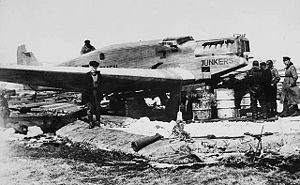Junkers W33
| W 33 | |
|---|---|
 |
|
| The W 33 Bremen after its historic Atlantic crossing. | |
| Role | Transport |
| Manufacturer | Junkers |
| First flight | 17 June 1926 |
| Introduction | Herman Pohlmann |
| Produced | 1927-34 |
| Number built | 199 |
| Variants | Junkers W 34 |
The Junkers W 33 was a German single-engine transport aircraft. It was aerodynamically and structurally advanced for its time (1920s), a clean, low-wing all-metal cantilever monoplane. Almost 200 were produced. It is remembered in aviation history for the first east–west non-stop heavier-than-air crossing of the Atlantic.
The Junkers W 33 was a transport development of the 1919 four-seat airliner, the Junkers F 13. The latter was a very advanced aircraft when built, an aerodynamically clean all-metal cantilever (without external bracing) monoplane. Even later in the 1920s, it and other Junkers types were unusual as unbraced monoplanes in a biplane age, with only Fokker's designs of comparable modernity. Like all Junkers designs from the J 7 fighter onwards, it used an aluminium alloy duraluminum structure covered with Junkers' characteristic corrugated dural skin. The wings had the same span as the F 13, though the platform was a little different, and the length was the same as the F 13FE. The fuselage, though, was flatter-topped than that of the F 13. A large port-side door gave access to the freight compartment. The 228 kW Junkers L5 upright inline water-cooled engined was also the same as in the F 13FE, though much more powerful than the BMW motors of the F 13A, giving improved weightlifting compared with that early model. The designer of the W 33 was Herman Pohlmann.
The cockpit and undercarriage were of their time, the former enclosed with two seats, and the latter fixed and divided with a tailwheel. The Junkers W letter labelled the type as a seaplane (floatplane), but in practice W 33s flew as both at different times. The prototype W 33, registered D-921, first flew, as a seaplane, from Leopoldshafen on the river Elbe near Dessau on 17 June 1926.
Production began in 1927 and ran until 1934 with 198 production machines built. Most of these were built at the Junkers works at Dessau, but a small number were assembled at Junker's Swedish subsidiary AB Flygindustri at Limhamn near Malmö and in the USSR. The Swedish plant had been set up in the early 1920s to avoid the post-war restrictions on aircraft building, which included civil types during 1921-2. The Russian works at Fili near Moscow was used initially to build the H 21 and H 22 fighters for the Red Army. There were over 30 W 33 variants, so only a few are listed below.
...
Wikipedia
